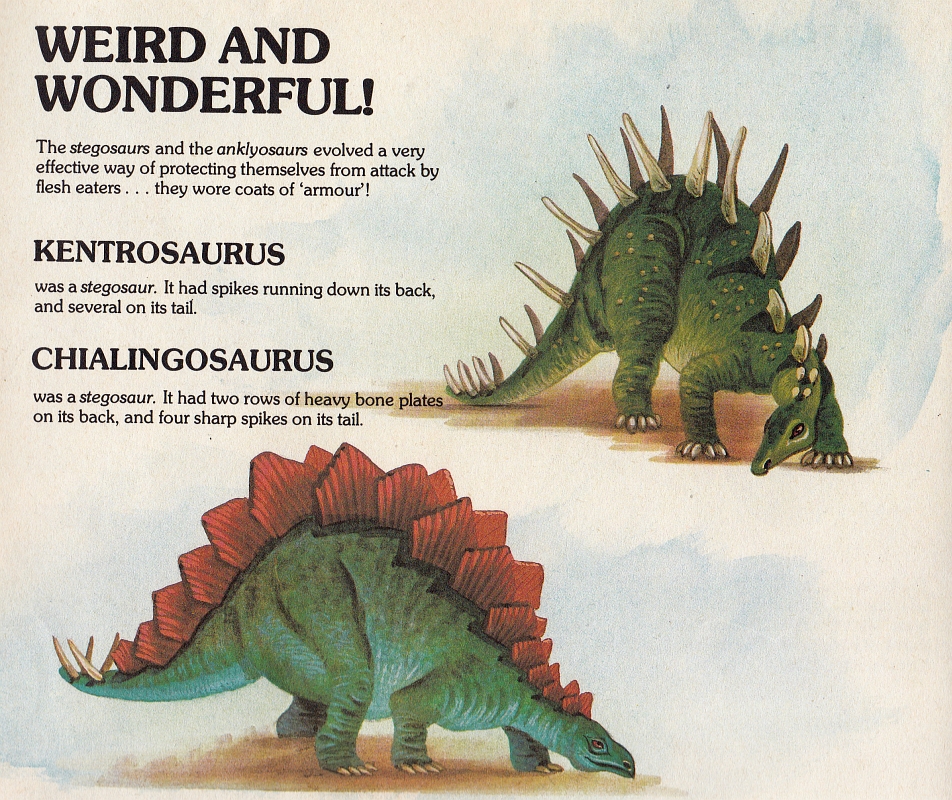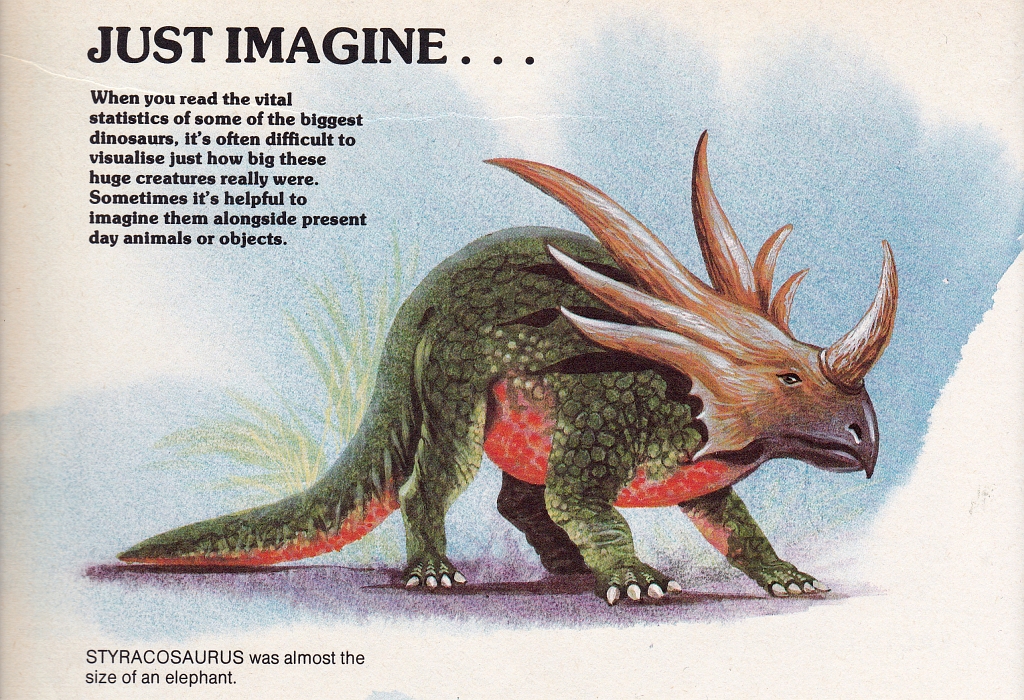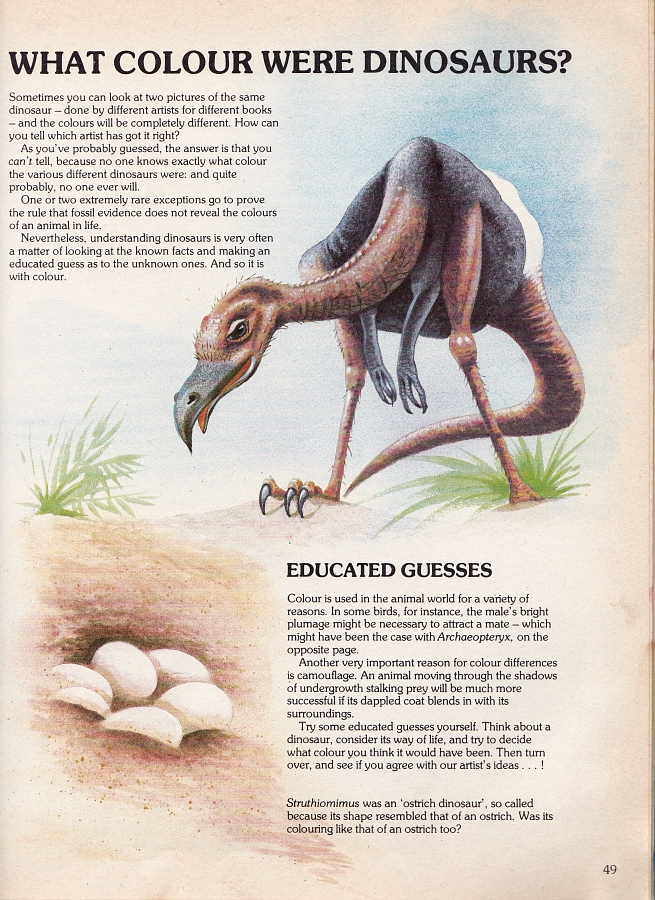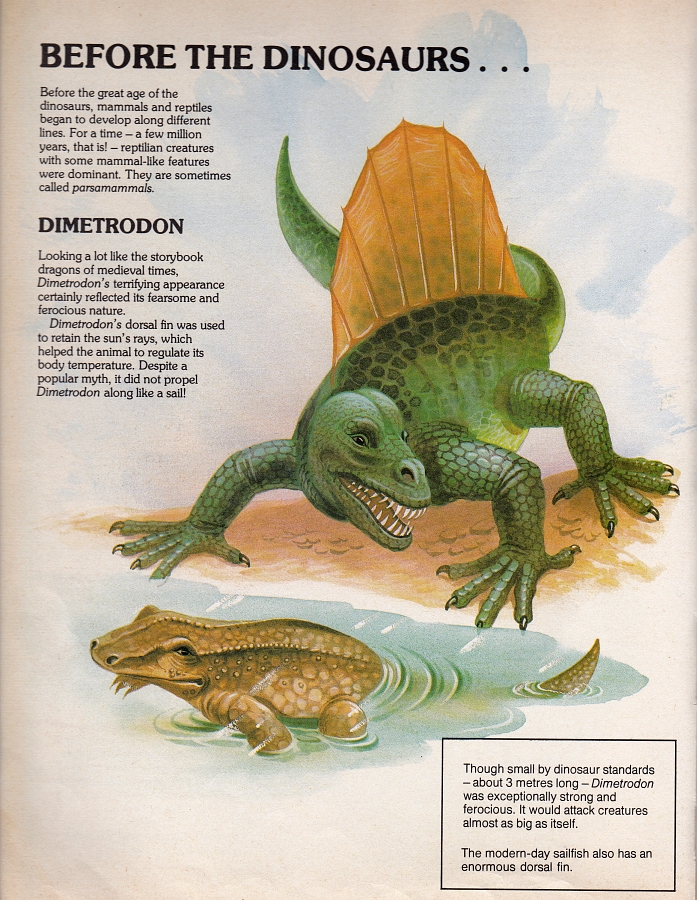Remember the St Michael dinosaur book, published in 1978 and notably featuring quite handsomely painted illustrations by Bernard Robinson? Discovering Dinosaurs, published a decade later by Cliveden Press, was illustrated by someone who evidently had a very well-thumbed copy of the earlier tome. I say ‘someone’, because neither the illustrator nor author here are credited, which is rather surprising. Then again, given the levels of Utter Shamelessness on show here, perhaps it’s because they’d rather their names weren’t attached to this thing…

The cover gives us an excellent idea of what to expect; the tyrannosaur is copied from a very familiar Robinson piece in which it’s being charged by Triceratops, while the Stegosaurus is based on another (entirely separate) Robinson illustration. Here, they’re anachronistically mashed together like an ignorant child playing with a box of dinosaur toys. Mind you, we’re at least treated to the sight of Sexy Rexy having his foot impaled on a spike in a rather eye-watering fashion (although, it’s probably still preferable to being gored in the privates, as in the original). Violence! Bright colours! Well-known dinosaurs! Look at this, kids, LOOK AT IT!

Speaking of familiar faces, here’s Megalosaurus getting extremely stuck into a carcass, another obvious copy from the St Michael book, albeit of a piece not illustrated by Robinson. In fact, the original was illustrated by an anonymous agency artist, and so here we have an anonymous artist copying another anonymous artist. Palaeoart in the 1980s, eh? In the original, the animal’s foot is partially hidden by perspective, and foreshortened; here, it’s just…missing. Perhaps simply to make way for the white space allocated for the text box, but it really does look as if it’s simply been severed. Nice. The ‘no neck’ look is carried over from the original.

While Stegosaurus might have been transposed into a more violent situation, Iguanodon is saved from a bloody battle with a large theropod. A big ol’ giraffe-like tongue is added because, well, tongue-lolling Iguanodon was de rigueur back then. This is at least a more competent copy of the original, and I like that Iguanodon is given a bit of a break. Bless its stabby little (in reality, huge) hands.

Continuing the ‘Giants’ Gallery’, here’s a Brachiosaurus that is something of a generic Bargain Bin Sauropod, with limb musculature that becomes all the more troubling the longer one spends inspecting it. In particular, it appears almost as if the animal has a vertical scapula that feeds…something into its neck. I’m fond of that minimalist watercolour background, though. The description of its diet as “vegetation – and plenty of it!” also raises a smile.

On the matter of strange and unusual limbs, check out the arms on this Gorgosaurus, apparently painted by an artist who didn’t trouble themselves with spending too long considering how an animal’s skeleton fits together. It also has six well-developed fingers, which I imagine is purely to annoy the more precocious child reader. Perhaps that’s why this book’s previous owner drew an outline around it in pen – they were singling out the most inaccurate reconstructions in this book. Then again, probably not.

I’ve included the above stegosaurs simply to draw attention to the plate arrangement on the Chialingosaurus. While Chialingosaurus has tended to be interpreted as being more Kentrosaurus-like than is indicated here, we can at least be confident that it didn’t have plates inspired by M C Escher.

The book’s ceratopsians have equally strange flourishes – like this Monoclonius with its strangely-shaped head that has the appearance of exposed bone. Or perhaps, one could argue, such an appearance is simply the result of selectively colouring certain parts of the head in an off-white, and others in the same grey as the rest of the body, thus masking the true contours of the skull. Could it be that I’m simply not giving the artist enough credit? Well…

…We also have this Styracosaurus, with a head that appears to be constructed of gnarled wood, possibly struck by lightning. It’s outlandish, to say the least, but then again, perhaps one could argue that this is an intriguing example of a ceratopsian with a strongly-contrasting head long before Collecta started slapping them on their toys? Could this be held up as a rare example of daring speculation from an age in which ceratopsians tended to be uniformly brown, grey, or grey-brown? Hey, this contrarianism lark is easy. I should be writing columns for the Daily Telegraph.

One does hope that we can all agree that this Pachycephalosaurus is very, very strange. It looks like the rubbery head of an old Doctor Who or Star Trek creature, and is surely all the more memorable for it. Wonderful stuff.

As for this thing (above), I’m really at a loss as to where it came from; there doesn’t seem to an equivalent in the St Michael book. Again, one could argue that sticking wispy filaments on an ornithomimosaur (for this is Struthiomimus, as per the text) is very progressive for 1988, but then again, the whole thing is so hideously bizarre-looking that it’s hard to appreciate its finer qualities. Why the hooked raptorial beak? Why the worm-like tail? What’s going on with the limbs? Why, why, why?

And finally…Dimetrodon, as imagined for a Medieval bestiary, hunts a temnospondyl-frog. Anatomy is thrown out of the window completely here, and then spat on, sucked into a nearby street cleaning machine and shredded. My favourite feature must surely be the strongly divergent thumbs. Why? WHY? We’ll be forever asking.







3 Comments
T.K. Sivgin
April 13, 2023 at 9:32 amThe Dimetrodon has two left thumbs, lmao.
Niels Hazeborg
April 13, 2023 at 11:00 amWhat an intriguing book. That ornithomimus vulture thing is something else, and the Styracosaurus would make a great Pokemon design. Copying artwork from better books is boring, coming up with inexplicably cazy designs of your own is much more interesting.
paleocharley
April 17, 2023 at 6:05 pmThanks for bringing this one to my attention, Marc. I’ve never heard of it, and with such a common tile and no author credit, it’s not showing up on Amazon. The Monoclonius reminds me of one of the critters in Dougal Dixon’s The New Dinosaurs.
As to T.K.’s suggestion above as to Dimetrodon having two thumbs, perhaps the illustrator was thinking of the Chirotherium tracks, which have an outer finger that appeared to be opposable.